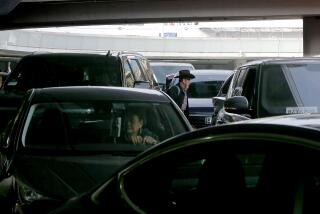The Daily Quest for Gridlock Wormholes
Some cities have mercurial weather. L.A. has tempestuous traffic. Indeed, Southern California media give our most frustrating phenomenon tornado treatment, taking much of their gridlock intel from the government, then sexing it up with their own promotional gimmickry and, in rare cases, original reportage.
Caltrans spreads news about construction, wrecks and bumper-to-bumper rubber-neckers with 330 electronic freeway signs in Ventura and L.A. counties.
Where else do L.A.’s 6 million daily commuters turn in their quest to find those elusive wormholes through the chaotic brake-light continuum?
— Compiled by Michael Soller and Benna Gottfried
Television News
Forget morning coffee, and let KTLA Channel 5’s “Traffic Pulse” set yours racing. Or maybe the blinking yellow, red and green dots on KNBC Channel 4’s freeway map get you going.Each news station interprets the traffic speed and volume data from Caltrans sensors that are embedded in each freeway lane every half-mile.
“People have come to rely on traffic reports,” Caltrans spokeswoman Gene Bonfillio said. “Traffic is news here.” The stations supplement Caltrans data with California Highway Patrol accident and SigAlert, or lane-closure, reports (posted at https://cad.chp.ca.gov), from their own traffic planes or helicopters.
KNBC offers 3D freeway graphics every 10 minutes that include topography and buildings, so drivers can visualize the traffic nightmare they are waking up to. Plus, a traffic ticker crawls across the screen, a prelude to the slow-motion drive ahead.
If virtual victimization isn’t your thing, Channel 5’s “Traffic Pulse” predicts drive times and compares them with average commutes on regularly traveled routes every seven to 10 minutes.
Or maybe you’re the punctual type: KABC Channel 7 reports road conditions “on the sevens.”
*
Internet
For the afternoon commute, a TV or radio is not usually at hand. You could try Caltrans’ site (https://dot.ca.gov/traffic/ target=”_blank”>dot.ca.gov/traffic/”). But like the freeway system it runs, the website is overbuilt and balky. Don’t worry. Broadcasters have colonized the Internet, providing online versions of their continuously updated traffic information.Nicole Stevenson of KNBC says the hits on the station’s traffic website are at their highest numbers during the lunch hour, from noon to 1 p.m. and around 4 p.m., just as people are preparing to leave work. And studies show online traffic news matters: 87% of participants in a traffic-industry-sponsored focus group said they changed their routes or delayed their departures because of those blinking freeway maps.
*
Radio
Whether it’s the familiar whir of KFWB News 980 AM’s Jetcopter or the familiar whine of the traffic reporters on many of the area’s approximately 80 stations, nearly 50% of commuters get their gridlock guidance from radio, compared with about 25% from TV and 4% from the Web.Public stations 89.3 FM KPCC and 89.9 FM KCRW insert traffic updates between sonorous National Public Radio segments. News radio stations KFWB or KNX 1070 AM, however, provide the most frequent and comprehensive reports.
Every year, transit authorities hand out awards to traffic reporters who plug carpooling and other traffic-calming techniques.
But public service only goes so far. “We’re much more sensational than in other cities,” KFWB reporter Scott Greene told The Times last year. “We go for the drama.”
*
In-Car Gadgets
A hand-held system called TrafficGauge, developed by a Seattle-based company, downloads 850 miles of Caltrans freeway data in L.A. and Orange County every four minutes. A Times reviewer found it “kept me out of trouble almost all the time.” But then there’s the cost: $80 for the PDA-sized device, plus a $7 monthly fee. GM’s OnStar navigation system provides an optional extended package for $35 a month that includes traffic advice, and radio powerhouse Clear Channel launched a traffic-message channel in January — for $60 a year, plus the dashboard navigation device, which can cost you $1,300 or more.More to Read
A cure for the common opinion
Get thought-provoking perspectives with our weekly newsletter.
You may occasionally receive promotional content from the Los Angeles Times.






